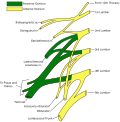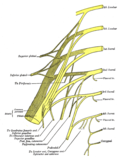Nerve plexus
Nerve Plexus
A Nerve Plexus is a complex network of intersecting nerves. They are responsible for combining sets of spinal nerves that serve the same area of the body into one large grouped nerve. There are several major nerve plexuses in the body, including the cervical plexus, brachial plexus, lumbar plexus, and sacral plexus.
Anatomy[edit]
The nerve plexus is formed by the anterior rami of the spinal nerves, excluding the thoracic spinal nerves T2-T12, which form the intercostal nerves. Each plexus is responsible for providing motor and sensory functions to a specific region of the human body.
Cervical Plexus[edit]
The cervical plexus is located in the neck, formed by the anterior rami of the first four cervical spinal nerves (C1-C4). It supplies motor and sensory innervation to the skin and muscles of the neck and parts of the head and shoulders.
Brachial Plexus[edit]
The brachial plexus is a network of nerves that originate in the neck and provide motor and sensory innervation to the upper limb. It is formed by the anterior rami of the fifth to eighth cervical spinal nerves and the first thoracic spinal nerve (C5-T1).
Lumbar Plexus[edit]
The lumbar plexus is located in the lower back, formed by the anterior rami of the first to fourth lumbar spinal nerves (L1-L4). It supplies motor and sensory innervation to the lower abdomen and parts of the lower limbs.
Sacral Plexus[edit]
The sacral plexus is located in the pelvis, formed by the anterior rami of the fourth and fifth lumbar spinal nerves and the first to fourth sacral spinal nerves (L4-S4). It supplies motor and sensory innervation to the buttocks, genitals, thighs, calves, and feet.
Clinical Significance[edit]
Damage or injury to a nerve plexus can lead to loss of motor or sensory function in the corresponding region of the body. This can result in conditions such as brachial plexus injury, lumbar plexus injury, or sacral plexus injury.
See Also[edit]
Nerve_plexus[edit]
-
Spinal Nerve Plexuses
-
Spinal Nerve CAT
-
Nerve Plexus
-
Brachial Plexus
-
Lumbar Plexus
-
Nerve Plexus
-
Spinal Nerve CAT
-
Nerve Plexus
-
Brachial Plexus
-
Lumbar Plexus
-
Nerve Plexus
Ad. Transform your life with W8MD's Budget GLP-1 injections from $75


W8MD offers a medical weight loss program to lose weight in Philadelphia. Our physician-supervised medical weight loss provides:
- Weight loss injections in NYC (generic and brand names):
- Zepbound / Mounjaro, Wegovy / Ozempic, Saxenda
- Most insurances accepted or discounted self-pay rates. We will obtain insurance prior authorizations if needed.
- Generic GLP1 weight loss injections from $75 for the starting dose.
- Also offer prescription weight loss medications including Phentermine, Qsymia, Diethylpropion, Contrave etc.
NYC weight loss doctor appointmentsNYC weight loss doctor appointments
Start your NYC weight loss journey today at our NYC medical weight loss and Philadelphia medical weight loss clinics.
- Call 718-946-5500 to lose weight in NYC or for medical weight loss in Philadelphia 215-676-2334.
- Tags:NYC medical weight loss, Philadelphia lose weight Zepbound NYC, Budget GLP1 weight loss injections, Wegovy Philadelphia, Wegovy NYC, Philadelphia medical weight loss, Brookly weight loss and Wegovy NYC
|
WikiMD's Wellness Encyclopedia |
| Let Food Be Thy Medicine Medicine Thy Food - Hippocrates |
Medical Disclaimer: WikiMD is not a substitute for professional medical advice. The information on WikiMD is provided as an information resource only, may be incorrect, outdated or misleading, and is not to be used or relied on for any diagnostic or treatment purposes. Please consult your health care provider before making any healthcare decisions or for guidance about a specific medical condition. WikiMD expressly disclaims responsibility, and shall have no liability, for any damages, loss, injury, or liability whatsoever suffered as a result of your reliance on the information contained in this site. By visiting this site you agree to the foregoing terms and conditions, which may from time to time be changed or supplemented by WikiMD. If you do not agree to the foregoing terms and conditions, you should not enter or use this site. See full disclaimer.
Credits:Most images are courtesy of Wikimedia commons, and templates, categories Wikipedia, licensed under CC BY SA or similar.
Translate this page: - East Asian
中文,
日本,
한국어,
South Asian
हिन्दी,
தமிழ்,
తెలుగు,
Urdu,
ಕನ್ನಡ,
Southeast Asian
Indonesian,
Vietnamese,
Thai,
မြန်မာဘာသာ,
বাংলা
European
español,
Deutsch,
français,
Greek,
português do Brasil,
polski,
română,
русский,
Nederlands,
norsk,
svenska,
suomi,
Italian
Middle Eastern & African
عربى,
Turkish,
Persian,
Hebrew,
Afrikaans,
isiZulu,
Kiswahili,
Other
Bulgarian,
Hungarian,
Czech,
Swedish,
മലയാളം,
मराठी,
ਪੰਜਾਬੀ,
ગુજરાતી,
Portuguese,
Ukrainian







